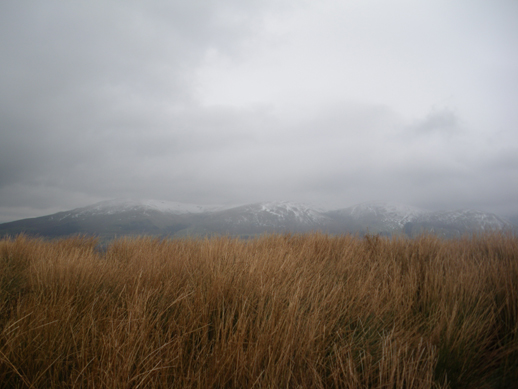 Howgills from the moors: Joel Hitchins-Samson
Howgills from the moors: Joel Hitchins-Samson
by Lisa Samson
Approaching Sedbergh from Kirby Lonsdale, the hills of the Howgills rise like giant sugar heaps, sprinkled with snow. In complete contrast to the craggy limestone outcrops of nearby Dentdale and Ingleborough, they are formed out of hard humps of sandstone. Sedbergh is an ancient grey-faced town at the confluence of four rivers: the Lune, the Rawthey, the Clough and the Dee. Although it is officially part of the Yorkshire Dales National Park, it is actually in Cumbria.
Eager to explore, we head up the track that leads to Cautley Spout, passing a cluster of snowdrops hanging their modest heads despite the winter sun. We pass two Shetland ponies, their heads too big for their stunted bodies. Along a track we turn uphill past an elegant Edwardian farm house and begin our ascent across fields where we find boundaries of ash and hawthorn. The ash trees have been pollarded some time ago and their trunks have split and grown horizontally outwards so that they resemble the backs of conjoined rhinoceroses.
North wards, we skirt the foot of the Spout, walking on a ridge that looks down on the valley. We can see a few fields of lamas below us, and through binoculars their teddy bear features on their long necks are easily identified. It is damp and slimy underfoot, and we jump over many streams trickling down hill. After Fawcett waterfall, an avenue of knotty hawthorns curls together over our heads. There are no buds on these trees but a soft verdant moss covers the lowest boughs and lichens flower on their gnarled branches. I recognise the miniature ferns of the Thuidium tamariscinum lichen and marvel at the way patterns are replicated in nature. Lichen thrives in the damp North West where clean winds blow in from the sea.
The sheer side of Cock Brow is thick with gorse, the lowest plants already flowering. When you rub a yellow bud between thumb and forefinger it emanates its familiar coconut scent. We meet a friendly farmer who tells us that tomorrow will also be sunny and dry, so on the Saturday morning we set out early and, such is our faith in the wisdom of a dalesman, we ignore the mist shrouding the hills, convinced that it will rise when the sun comes out. Our route today takes us over Frostrup Moors and into Dentdale, the next valley.
We walk into swirling mist, with the wind howling in the trees and the rain drumming on our hoods. The moor land grasses sway in the wind and, once I am in my stride, I become a self-contained vessel swept along on a tide. The water logged moor is spongy and I bounce happily for a mile or so, slogging joyfully into the wind. The soles of my feet can feel the textures of slimy rocks and coarse grasses, reconnecting me with the earth.
I let the wind sweep me off the path and soon find myself lying across a stream, having slipped on the wet stones. I pull myself up, cursing the dog, who wags his tail as I direct my expletives at him. Sheltering against a dry stone wall that cuts jaggedly across the moors, we look back towards the Howgills, and notice that there are five curved hills guarding the town, five white domes like the roof of St Mark’s Basilica in Venice. We’ve reached the top of the moors and the bottom of our ordnance survey map, so we’re completely lost.
We slither down a sheep track that drops down the fell side into Dentdale, but it is a stream of mud, fit only for hooves, not feet. Instead of bleating a hasty retreat when they see our dog panting for a mouthful of them, the sheep gather around us and, in a panic, I slip onto my bottom and slide some distance. For a split second I think I’ll be trampled by their hard hooves, but Mike scares them off and comes to pick me up. I’m not hurt, just cold and muddy.
Shivering, I drag my heels for the final two miles along the Dales Way back to Sedbergh. Although muddy, the ancient walled track that we follow through fields is sheltered and pleasant, passing through a wood of oak and ash that don’t look too healthy. Many of the lower ash boughs are blackened and a number of the trees have been felled by the wind. Cold and tired, we crawl into the first pub we find, the Red Lion in Sedbergh, where we warm ourselves with wine and wood smoke.